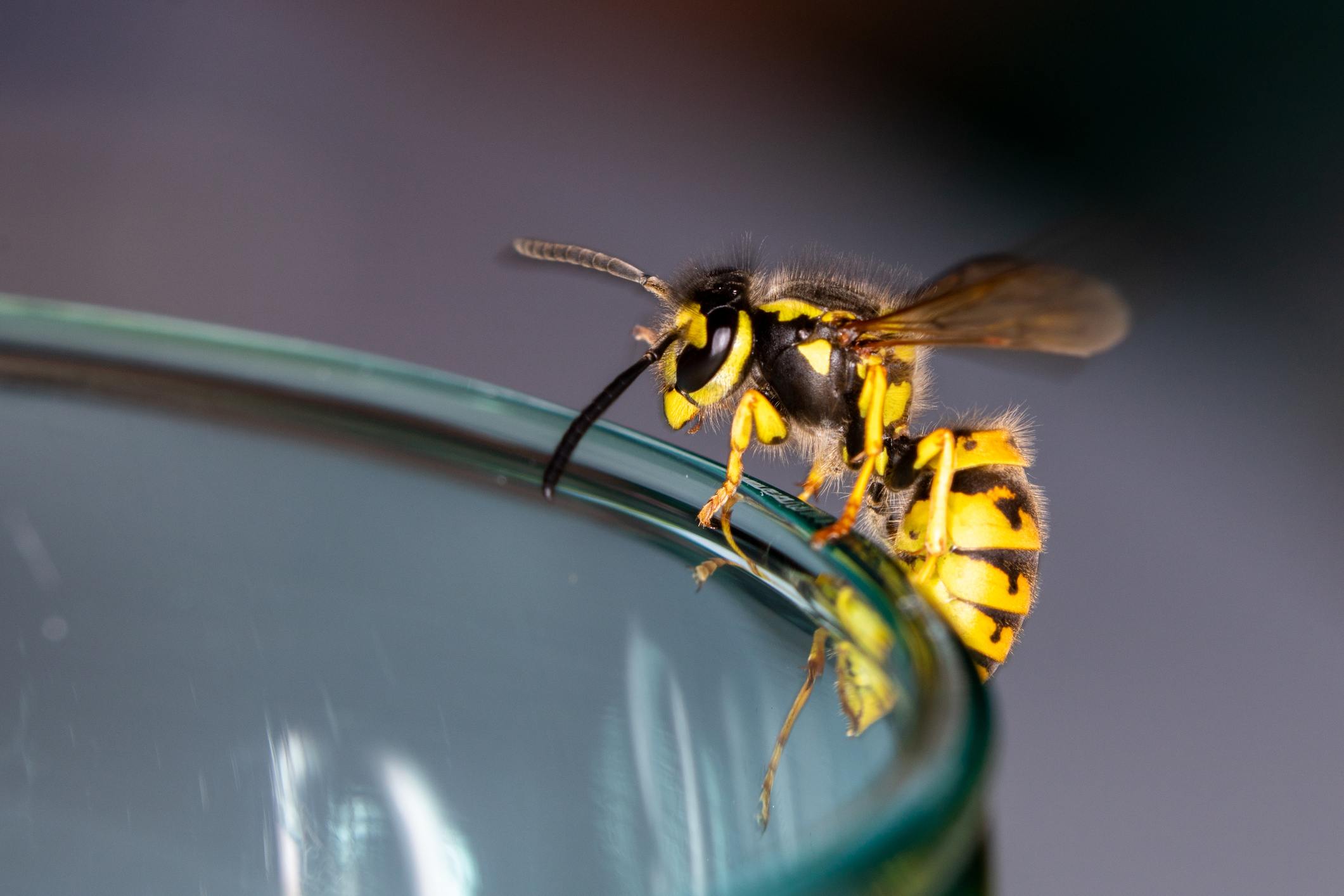Hornets, part of the Vespidae family, are some of the largest and most aggressive stinging insects in the world. Known for their distinct size and potent stings, hornets can pose a danger to both humans and other animals, especially if their nests are disturbed.
In Wisconsin, homeowners often encounter hornets during the late summer when colonies are at their largest. This guide will help you identify hornets, understand their behaviors, and take the necessary steps for hornet control and prevention.
HORNETS IN WISCONSIN
Wisconsin is home to a number of hornet species, with the European hornet and the bald-faced hornet being two of the most commonly encountered species. Both can be aggressive if their nests are threatened, and their presence can become a significant nuisance for homeowners.
In recent years, concerns about the Northern giant hornet, also known as the Asian giant hornet, have increased due to its sightings in North America. While it hasn’t been established in Wisconsin, residents should remain vigilant for this species.
What Do Hornets Look Like?
Hornets are distinct in appearance, making them easy to identify compared to other stinging insects in Wisconsin, such as bees and wasps. The key features to look for are:
- Size: Hornets are significantly larger than other social wasps, with the European hornet ranging from 1 to 1.5 inches, while the Northern giant hornet can grow to be over 2 inches long.
- Color: European hornets have reddish-brown heads, brown and yellow-striped abdomens, and brown wings. Bald-faced hornets, on the other hand, are black with white markings on their face, giving them their distinctive name.
- Body Structure: Like other members of the Vespidae family, hornets have a segmented body with a narrow waist (the connection between the thorax and abdomen) and two sets of wings.
- Stinger: Female hornets possess a smooth, powerful stinger, allowing them to sting multiple times without dying, unlike honey bees.
SIGNS OF A HORNET INFESTATION
Hornet infestations typically become noticeable during late summer and fall when the colony has reached its peak size. Common signs of a hornet infestation include:
- Increased Hornet Activity: If you notice hornets flying around your yard or home, especially near eaves, trees, or sheds, this could indicate the presence of a nearby nest.
- Visible Nests: Hornet nests are typically large, papery structures that can be found in trees, shrubs, under the eaves of buildings, or in wall voids. European hornets often build their nests in hollow trees or attics, while bald-faced hornets tend to build aerial nests in exposed locations.
- Aggressive Behavior: Hornets are generally more aggressive than other stinging insects, especially when defending their nests. If you notice hornets behaving aggressively near your home or yard, it’s possible there’s a nest nearby.
HABITAT, DIET, LIFE CYCLE & BEHAVIORS
Hornets are highly organized social insects that follow a distinct life cycle and exhibit specific behaviors. Their habitats and diet preferences also influence their interactions with humans.
WHERE DO HORNETS LIVE?
Hornets are versatile nesters, building their homes in a variety of locations. Their nests are made of chewed-up wood fibers, which the hornets combine with saliva to create a papery substance. They often build their nests in hollow trees, under logs, or within dense shrubs. These locations provide them with shelter and protection from predators. In urban and suburban areas, hornets frequently build nests in wall voids, attics, under eaves, or even inside garages and sheds. They may also nest underground in abandoned rodent burrows.
DIET
Hornets are carnivorous and play an important role in controlling pest populations, feeding on flies, caterpillars, and other insects (making them beneficial in gardens where they help control harmful pests). While they primarily hunt other insects, hornets also consume sweet substances, and in late summer, they develop a craving for sugary foods and will seek out nectar, fruit, and even human food scraps. This is why they are often seen hovering around picnic areas, garbage bins, and porch lights during this time.
LIFE CYCLE
Hornets go through a complete metamorphosis, following a life cycle that consists of four stages: egg, larva, pupa, and adult. In the spring, fertilized queens emerge from hibernation and begin constructing small nests where they lay their eggs. These eggs hatch into larvae, which the queen feeds with chewed-up insects. After several molts, the larvae spin a cocoon and pupate, developing into adult hornets inside the cocoon. The first adult hornets are sterile female workers, which take over nest expansion, foraging, and caring for the young. Later in the season, new queens and male drones are produced.
BEHAVIORS
Hornets are social insects, meaning they live in colonies with a strict hierarchy, led by a queen. Each colony contains sterile female workers, drones, and, in the later part of the season, new queens. Hornets are known for their defensive behavior, particularly around their nests, and will aggressively defend their colonies if they feel threatened. They are more likely to sting if their nest is disturbed and, unlike honey bees, hornets can sting multiple times without dying. Active foragers, hornets constantly hunt insects and search for sugary foods to feed their colony.
ARE HORNETS DANGEROUS?
Hornets are considered one of the more dangerous stinging insects due to their aggressive nature and ability to sting multiple times. Their stings are painful and can cause severe allergic reactions in some individuals. Hornet venom contains acetylcholine, which causes immediate pain, and in larger species like the Northern giant hornet, their venom can also damage tissue. For individuals with allergies, hornet stings can trigger anaphylaxis, a life-threatening reaction.
Because hornets have smooth stingers, they can sting multiple times, unlike honey bees, which die after stinging. A single hornet can deliver several painful stings if provoked and hornets are more aggressive than bees or wasps, particularly when defending their nests. They may chase intruders for several yards if they feel threatened. If you are allergic to stinging insect venom or experience frequent hornet activity near your home, it is important to contact a residential pest control service for safe removal and hornet control.
HOW TO GET RID OF HORNETS
If you have identified a hornet nest near your home or yard, it’s critical to handle the situation with care. Hornets can be dangerous when provoked, and attempting to remove a nest without professional help can lead to multiple stings.
The safest way to remove hornets is to contact a licensed pest control service like Terminix Wil-Kil that specializes in stinging insect control. Professionals have the protective gear and equipment necessary to safely remove hornet nests and eliminate the colony.
HOW TO PREVENT HORNETS
Preventing hornets from nesting around your home is the best strategy to avoid potential stings and infestations. By taking the following preventive measures, you can reduce the risk of hornets nesting near your home and minimize encounters with these stinging insects.
- Seal Entry Points: Inspect your home for any cracks or gaps in walls, roofs, and attics. Sealing these openings can prevent hornets from entering your home and nesting in wall voids or attics.
- Keep Food Sources Away: Ensure that outdoor garbage bins are tightly sealed and that food and sugary drinks are not left outside. Hornets are attracted to sweet foods and will forage in these areas if they are easily accessible.
- Eliminate Standing Water: Hornets are attracted to water sources, so eliminate any standing water in your yard, such as puddles or birdbaths, to reduce their attraction to your property.
- Monitor Outdoor Lights: Hornets are drawn to lights at night. Consider using yellow-tinted lights that are less attractive to insects or reduce outdoor lighting during peak hornet activity in late summer.
NEED HELP WITH STINGING INSECT CONTROL IN YOUR WISCONSIN HOME?
If you’ve spotted hornets around your home or suspect there is a nest nearby, it’s essential to take action to protect your family and property. Terminix Wil-Kil offers professional pest control services in Wisconsin and can help safely remove hornet nests and implement long-term prevention strategies.
FAQS
DO HORNETS STING?
Yes, hornets can sting and are capable of stinging multiple times. Their stings are painful and can trigger allergic reactions in some people.
HOW LONG DO HORNETS LIVE?
Worker hornets typically live for several weeks, while queens can live for up to one year. Queens hibernate during the winter and emerge in the spring to establish new colonies.
ARE HORNETS AGGRESSIVE?
Yes, hornets are generally more aggressive than other stinging insects, especially when defending their nests. They will chase and sting perceived threats if provoked.
DO HORNETS DIE AFTER THEY STING?
No, unlike honey bees, hornets do not die after they sting. They have smooth stingers that allow them to sting multiple times.
DO HORNETS HIBERNATE?
Only the queens hibernate during the winter. The rest of the colony dies off at the end of the season, and the queens emerge in the spring to start new colonies.
Related Posts From Our Blog
How to Get Rid of Wasps in the Winter
Spotting a wasp around your home can be alarming, especially during the winter season. Running across a wasp can also be an indication of more in the area. Some wasps survive the colder months by [...]
When Wasps Attack: Signs of a Wasp Infestation and How to Prevent One
Wasps are among the most intimidating stinging insects to encounter. While many bees can only sting you once, wasps can sting multiple times. Stings are painful, and can even trigger an allergic reaction. When you [...]
Bite- and Sting-Free Celebrations
For many of us, the outdoors has become an escape from day-to-day life as we try to find a new normal with COVID-19. Warm weather combined with the need for social distancing also means that [...]
Hornet Facts & Identification in Sun Prairie, WI
Terminix Wil-Kil Pest Control is a local Pest Control and Extermination company helping homeowners and businesses with pest issues across WI.





